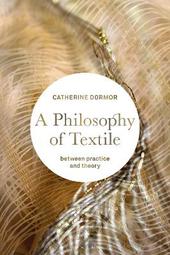
|
A Philosophy of Textile: Between Practice and Theory
Hardback
Main Details
| Title |
A Philosophy of Textile: Between Practice and Theory
|
| Authors and Contributors |
By (author) Catherine Dormor
|
| Physical Properties |
| Format:Hardback | | Pages:144 | | Dimensions(mm): Height 234,Width 156 |
|
| Category/Genre | Textile design and theory
Philosophy - aesthetics |
|---|
| ISBN/Barcode |
9781472525659
|
| Classifications | Dewey:746 |
|---|
| Audience | | Professional & Vocational | | Tertiary Education (US: College) | |
|---|
| Illustrations |
26 colour illus
|
|
Publishing Details |
| Publisher |
Bloomsbury Publishing PLC
|
| Imprint |
Bloomsbury Visual Arts
|
| NZ Release Date |
10 December 2020 |
| Publication Country |
United Kingdom
|
Description
Textile is at once a language, a concept and a material thing. Philosophers such as Plato, Deleuze and Derrida have notably drawn on weaving processes to illustrate their ideas, and artists such as Ann Hamilton, Louise Bourgeois and Chiharu Shiota explore matters such as the seam, the needle and thread, and the flow of viscous materials in their work. Yet thinking about textile and making textile are often treated as separate and distinct practices, rather than parallel modes. This beautifully illustrated book brings together for the first time the language and materiality of textile to develop new models of thinking, writing and making. Through the work of thinkers such as Roland Barthes, Helene Cixous and Luce Irigaray, and international artists like Eva Hesse and Helen Chadwick, textile practitioner, theorist and writer Catherine Dormor puts forward a new philosophy of textile. Exploring the material behaviours and philosophical language of folding, shimmering, seaming, viscosity, fraying and caressing, Dormor demonstrates how textile practice and theory are intricately woven together.
Author Biography
Catherine Dormor is a practising artist, Reader in Textile Practices and Head of Research Programmes and at the Royal College of Art, London UK.
ReviewsThe bibliography is extensive, giving an interesting insight into the metaphorical use of the words that textiles have made to the language. * Book Threads * Dormor provides a crucial model of integrated writing about practice that entwines the academic and creative voice. In the face of much writing that adopts linear models not because of their usefulness, but for lack of another model, here the academic and creative voice finally hold "theory" and "practice" as one. * Jessica Hemmings, National College of Art & Design, Dublin, Ireland *
|